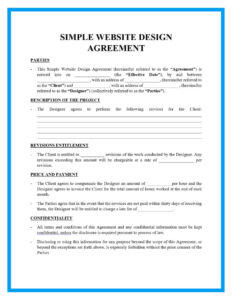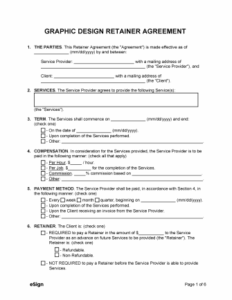Starting an interior design project is always exciting, filled with creative vision and the promise of transforming a space. However, amidst all the inspiration and design concepts, it is crucial to lay a solid foundation for your professional relationship with clients. This foundation is a comprehensive service agreement, a document that protects both your interests as a designer and ensures your client understands what to expect every step of the way.
Think of it as your project blueprint, but for the business side of things. Having a robust and clearly defined agreement in place eliminates ambiguities and paves the way for a smooth, successful collaboration. It is not just about formality; it is about setting clear expectations, managing potential challenges, and fostering trust from the very first consultation.
Why a Solid Interior Design Contract is Your Best Friend
In the bustling world of interior design, where creativity meets client expectations, having a well crafted contract is not just a suggestion; it is a necessity. This legal document serves as your professional shield, safeguarding your time, effort, and intellectual property. Without it, you might find yourself navigating misunderstandings, scope creep, or even payment disputes that could otherwise be easily avoided with clear terms upfront. It provides a formal framework that defines the project boundaries, ensuring that everyone involved is on the same page from concept development to the final reveal.
A strong agreement does more than just protect you; it empowers your business. It allows you to focus on what you do best design without the constant worry of miscommunication or unclarified expectations. When clients see a professional, detailed contract, it instills confidence in your services and demonstrates your commitment to a transparent and ethical business practice. It sets a professional tone right from the start, showing that you value your work and your clients investment equally.
Key Elements Your Contract Should Cover
Developing a comprehensive contract might seem daunting, but breaking it down into essential components makes it manageable. Each section plays a vital role in outlining the scope, responsibilities, and financial aspects of the project. Neglecting even one of these areas could lead to future complications, so careful attention to detail here is paramount.
- Client and Designer Information Clearly identify all parties involved with their full contact details.
- Scope of Work Detailed Outline every service you will provide, from initial consultation and concept development to material selection and project management. Be specific about what is included and what is not.
- Project Timeline and Deliverables Establish a realistic schedule for key milestones and final delivery, setting clear expectations for project duration.
- Payment Schedule and Fees Clearly state your fees, payment terms, deposit requirements, and consequences for late payments. Include details about how expenses for materials and subcontractors will be handled.
- Revisions and Change Orders Define the number of revisions included in your fee and how additional revisions or changes to the project scope will be handled and billed.
- Termination Clause Outline the conditions under which either party can terminate the agreement and the financial implications of such a termination.
- Intellectual Property Specify who owns the rights to designs, plans, and drawings created during the project.
Beyond these core elements, consider including clauses that address confidentiality, dispute resolution methods, and a disclaimer regarding third party services or products. Every project is unique, and your contract should reflect that flexibility while maintaining a strong legal backbone. Think about common scenarios that arise in interior design projects and proactively address them within your agreement.
Ultimately, a detailed agreement fosters a smoother workflow and a more enjoyable experience for everyone involved. It prevents the dreaded scope creep where a project expands beyond its initial boundaries without additional compensation or agreement. With a clear contract, you can confidently steer your projects, knowing that your professional boundaries and financial interests are well protected.
Making the Contract Template for Interior Design Services Work for You
While the idea of crafting a perfect contract from scratch can be intimidating, the good news is you do not have to. Utilizing a reliable contract template for interior design services can provide an excellent starting point. These templates are designed to cover the most common legal and business aspects of interior design projects, giving you a strong foundation to build upon. However, a template is just that a template. Its true value comes when you tailor it specifically to your business practices and the unique requirements of each project.
The key to making any template effective is customization. Do not just fill in the blanks; review each clause carefully. Does it align with how you run your business? Does it accurately reflect the services you offer and your fee structure? It is highly recommended to have a legal professional review your customized template. They can ensure it complies with local laws and regulations, and more importantly, that it adequately protects your specific interests as an interior designer. This small investment can save you significant headaches and costs down the line.
Beyond the legalities, consider how you will present and discuss the contract with your clients. A contract should be a tool for clarity, not confusion. Walk your clients through the document, explaining each section in plain language. Encourage questions and address any concerns they might have. This transparent approach builds trust and ensures that your client feels comfortable and confident signing the agreement, knowing exactly what they are committing to and what they can expect from you.
Remember that your contract is a living document, meaning it can and should evolve as your business grows and as industry standards change. Regularly review your contract template for interior design services to ensure it remains relevant and effective. Staying updated ensures that your agreements continue to serve as a strong, protective shield for your creative endeavors and professional relationships.
- Start with a clear understanding of your services and pricing.
- Customize the template for each project, reflecting specific scope and deliverables.
- Seek legal advice to ensure compliance and adequate protection.
- Communicate the contract terms transparently with your clients.
- Regularly review and update your template to adapt to business changes.
In the dynamic and often fast paced world of interior design, a well structured service agreement is more than just a piece of paper; it is an invaluable asset. It is the backbone of professional practice, providing clarity, protection, and a pathway to successful project completion. By investing time and care into your contract, you are not just safeguarding your business; you are elevating your professional image and building lasting, trusting relationships with your clients.
Embracing a comprehensive and thoughtfully prepared agreement ensures that your creative passion can flourish without the distraction of avoidable disputes or misunderstandings. It allows you to focus on designing beautiful, functional spaces, confident that the business aspects of your work are firmly and professionally managed. This commitment to clear agreements ultimately leads to happier clients, smoother projects, and a more fulfilling career in interior design.



